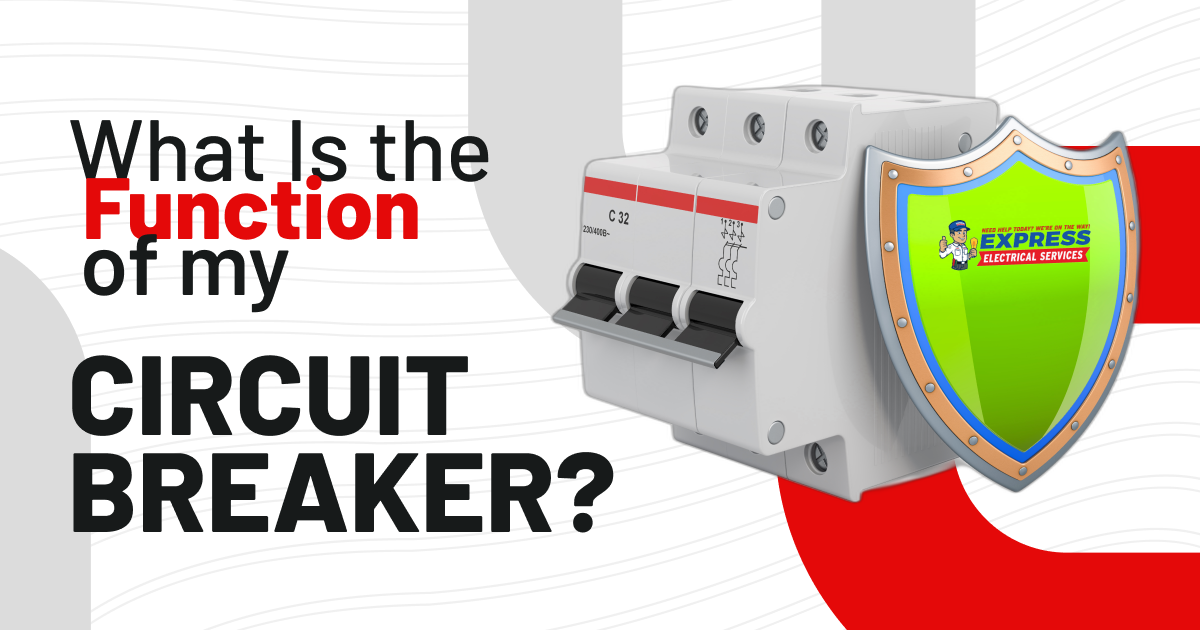What Is the Function of a Circuit Breaker?

Circuit breakers have a crucial function in your home electrical system. Each one is connected to an electrical circuit and automatically turns the power off to that circuit when it overloads. Without this protection, major damage can occur. We’ll look at the function of a circuit breaker to highlight its importance. Also, we’ll discuss how to use a circuit breaker when it trips or you need to turn off the power.
How Does a Circuit Breaker Work?
A typical residential circuit breaker consists of a mechanical switch through which electricity flows. An electromagnet is attached to this switch. It is influenced by electric current, so if the flow of electricity is strong enough, the electromagnet will pull on a lever, via a switch linkage, to cut power to the circuit.
Another variation of this design (a thermal-magnetic circuit breaker) features a bimetallic strip that becomes hotter the more current flows through the circuit. The strip will bend when the current rises above a certain threshold. At the same time, it will move a contact to break the connection.
What Causes a Circuit Breaker to Trip?
Before circuit breakers, fuses were used. But to break the circuit, they would blow out and would have to be replaced. A circuit breaker can be switched back on when the conditions that caused it to trip are resolved. Reasons for a breaker to trip include:
- Electrical Overload: An overloaded circuit is the most common reason for a tripped circuit breaker. The function of a circuit breaker is to prevent the wire from becoming hot enough to melt its insulation and allow electricity to escape the conductor, which can cause a fire.
An overload occurs due to having too many devices or appliances plugged in at once, which exceeds the circuit’s load capacity. Unplugging devices is an easy way to resolve the problem. The power should be restored when you turn the breaker back on.
- Short Circuit: Your home electrical system consists of black live/hot wires, white neutral wires, and bare copper ground wires. A short circuit occurs when the hot wire and neutral wire, ground wire, or other metal touch. This floods the circuit with current due to a lack of electrical resistance, causing an overload.
Defective or damaged wiring, a loose connection, or a problem with an outlet or light switch can cause a short circuit. Short circuits also originate in extension cords, power strips, and appliances. Often accompanied by a burning smell or smoke, a short circuit is a fire and electrocution risk.
- Ground Fault Surge: A ground fault surge is a short circuit resulting from the hot wire touching the ground wire or the metal electrical box the ground wire connects to. It can occur due to damaged or poorly insulated wiring or if water enters an outlet. A ground fault surge is more dangerous than a typical short circuit. It can be prevented by installing ground fault circuit interrupter (GFCI) outlets, especially in a bathroom, kitchen, or basement.
It’s also possible a frequently tripping circuit breaker can be faulty. Or the issue can be that your electrical panel is old, outdated, or not wired properly.
How Do I Reset a Circuit Breaker After It Trips?
Resetting a circuit breaker after it trips should be simple. First, you must find the breaker that has tripped. Open the door to the main electrical panel; the breakers are arranged in vertical rows. Each 120-volt breaker is connected to one hot bus bar, while 240-volt breakers are each connected to two hot bus bars (these receive power from the main breaker).
The circuit breakers should be switched to the “On” position. Therefore, it won’t be difficult to find one that is in the middle, between the “On” and “Off” positions. This is the tripped breaker and no electrical appliance or device on that circuit will be working. When you find it, determine if the circuit is overloaded and unplug some devices. If you’re sure the circuit is no longer overloaded, flip the breaker to the “On” position. If it won’t hold or trips again soon after, call an electrician.
Is It OK to Shut a Circuit Breaker Off Manually?
Circuit breakers can be safely turned off manually. Every homeowner should know how to use a circuit breaker. You can cut power to a circuit by locating its corresponding breaker switch and flipping it to the “Off” position. The breaker can be switched on again after the issue has been resolved or fixed.
You can also switch the main breaker off, especially if an electrical issue is affecting your entire home. But turn all the branch circuit breakers off first. To prevent the main breaker from overloading, reset it and then turn each branch circuit breaker on one at a time.
When Should I Call an Electrician?
The function of a circuit breaker is vital to the function and safety of your home. If damaged, it must be replaced by a licensed electrician. Call a professional if:
- The breaker trips repeatedly
- A breaker switch is loose
- A breaker is physically damaged
- The metal around it looks burned
- You see rust or corrosion
- The breaker box is hot
- There’s a burning odor
- The breaker is old
Contact Express Electrical Services
Our licensed technicians provide all types of electrical services in Los Angeles and Southern California. Whether you need a circuit breaker replaced, A GFCI installed, or your home re-wired, we can get the job done. Our team is also available 24/7 to help in electrical emergencies. If you have any further questions about the function of a circuit breaker, you’re having trouble resetting one, or you suspect an electrical problem for any other reason, call (323) 204-4132 We can be at your home in 60-90 minutes!

Leave A Comment